
The Lamiaceae or Labiatae are a family of flowering plants commonly known as the mint, deadnettle, or sage family. Many of the plants are aromatic in all parts and include widely used culinary herbs like basil, mint, rosemary, sage, savory, marjoram, oregano, hyssop, thyme, lavender, and perilla, as well as other medicinal herbs such as catnip, salvia, bee balm, wild dagga, and oriental motherwort. Some species are shrubs, trees, or, rarely, vines. Many members of the family are widely cultivated, not only for their aromatic qualities, but also their ease of cultivation, since they are readily propagated by stem cuttings. Besides those grown for their edible leaves, some are grown for decorative foliage. Others are grown for seed, such as Salvia hispanica (chia), or for their edible tubers, such as Plectranthus edulis, Plectranthus esculentus, Plectranthus rotundifolius, and Stachys affinis. Many are also grown ornamentally, notably coleus, Plectranthus, and many Salvia species and hybrids.

The Polygonaceae are a family of flowering plants known informally as the knotweed family or smartweed—buckwheat family in the United States. The name is based on the genus Polygonum, and was first used by Antoine Laurent de Jussieu in 1789 in his book, Genera Plantarum. The name may refer to the many swollen nodes the stems of some species have, being derived from Greek [poly meaning 'many' and gony meaning 'knee' or 'joint']. Alternatively, it may have a different origin, meaning 'many seeds'.

Genus is a taxonomic rank above species and below family as used in the biological classification of living and fossil organisms as well as viruses. In binomial nomenclature, the genus name forms the first part of the binomial species name for each species within the genus.

The Scrophulariaceae are a family of flowering plants, commonly known as the figwort family. The plants are annual and perennial herbs, as well as shrubs. Flowers have bilateral (zygomorphic) or rarely radial (actinomorphic) symmetry. The Scrophulariaceae have a cosmopolitan distribution, with the majority found in temperate areas, including tropical mountains. The family name is based on the name of the included genus Scrophularia L.

Myrtaceae, the myrtle family, is a family of dicotyledonous plants placed within the order Myrtales. Myrtle, pōhutukawa, bay rum tree, clove, guava, acca (feijoa), allspice, and eucalyptus are some notable members of this group. All species are woody, contain essential oils, and have flower parts in multiples of four or five. The leaves are evergreen, alternate to mostly opposite, simple, and usually entire. The flowers have a base number of five petals, though in several genera, the petals are minute or absent. The stamens are usually very conspicuous, brightly coloured, and numerous.
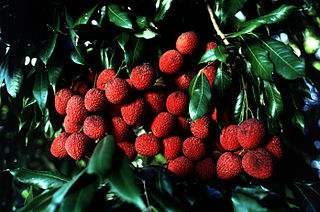
The Sapindaceae are a family of flowering plants in the order Sapindales known as the soapberry family. It contains 138 genera and 1,858 accepted species. Examples include horse chestnut, maples, ackee and lychee.

Plantaginaceae, the plantain family, is a large, diverse family of flowering plants in the order Lamiales that includes common flowers such as snapdragon and foxglove. It is unrelated to the banana-like fruit also called "plantain." In older classifications, Plantaginaceae was the only family of the order Plantaginales, but numerous phylogenetic studies, summarized by the Angiosperm Phylogeny Group, have demonstrated that this taxon should be included within Lamiales.

The Gelechiidae are a family of moths commonly referred to as twirler moths or gelechiid moths. They are the namesake family of the huge and little-studied superfamily Gelechioidea, and the family's taxonomy has been subject to considerable dispute. These are generally very small moths with narrow, fringed wings. The larvae of most species feed internally on various parts of their host plants, sometimes causing galls. Douglas-fir (Pseudotsuga) is a host plant common to many species of the family, particularly of the genus Chionodes, which as a result is more diverse in North America than usual for Gelechioidea.

The Onagraceae are a family of flowering plants known as the willowherb family or evening primrose family. They include about 650 species of herbs, shrubs, and trees in 17 genera. The family is widespread, occurring on every continent from boreal to tropical regions.
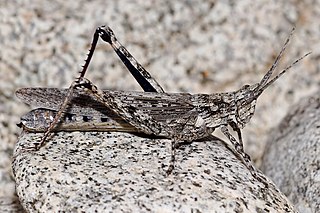
Acrididae are the predominant family of grasshoppers, comprising some 10,000 of the 11,000 species of the entire suborder Caelifera. The Acrididae are best known because all locusts are of the Acrididae. The subfamily Oedipodinae is sometimes classified as a distinct family Oedipodidae in the superfamily Acridoidea. Acrididae grasshoppers are characterized by relatively short and stout antennae, and tympana on the side of the first abdominal segment.
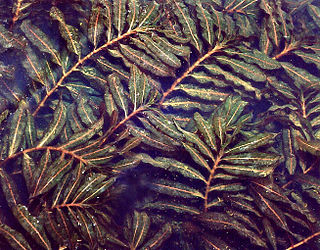
The Potamogetonaceae, commonly referred to as the pondweed family, is an aquatic family of monocotyledonous flowering plants. The roughly 110 known species are divided over six genera. The largest genus in the family by far is Potamogeton, which contains about 100 species.

Eurotiomycetes is a large class of ascomycetes with cleistothecial ascocarps within the subphylum Pezizomycotina, currently containing around 3810 species according to the Catalogue of Life. It is the third largest lichenized class, with more than 1200 lichen species that are mostly bitunicate in the formation of asci. It contains most of the fungi previously known morphologically as "Plectomycetes".

The Berberidaceae are a family of 18 genera of flowering plants commonly called the barberry family. This family is in the order Ranunculales. The family contains about 700 known species, of which the majority are in the genus Berberis. The species include trees, shrubs and perennial herbaceous plants.
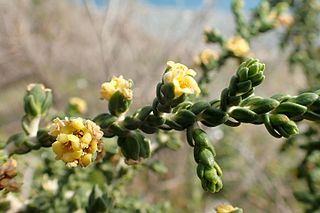
The Thymelaeaceae are a cosmopolitan family of flowering plants composed of 50 genera and 898 species. It was established in 1789 by Antoine Laurent de Jussieu. The Thymelaeaceae are mostly trees and shrubs, with a few vines and herbaceous plants.

Mesostigmata is an order of mites belonging to the Parasitiformes. They are by far the largest group of Parasitiformes, with over 8,000 species in 130 families. Mesostigmata includes parasitic as well as free-living and predatory forms. They can be recognized by the single pair of spiracles positioned laterally on the body.

Chrysococcus is a genus of golden algae in the family Dinobryaceae.
Chrysococcus elegans is a species of golden algae in the family Dinobryaceae. It is a freshwater species found in North America, specifically the Northwest Territories in Canada.
Stylobryon is a monotypic genus of golden algae in the family Dinobryaceae. It has one known species Stylobryon insignisFromental, 1874.
The Pteridophyte Phylogeny Group (PPG) is an informal international group of systematic botanists who collaborate to establish on the classification of pteridophytes that reflects knowledge about plant relationships discovered through phylogenetic studies. In 2016, the group published a classification for extant pteridophytes, termed "PPG I". The paper had 94 authors . The classification was presented as a consensus classification supported by the community of fern taxonomists, but it has been partially exclusive and is highly contested. Alternative classifications of ferns exist and are preferred by more general taxonomists.
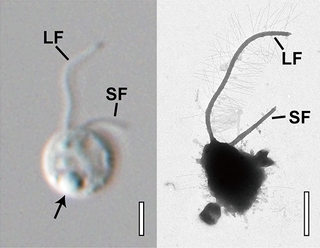
Ochromonadales is an order of single-celled algae belonging to the class Chrysophyceae, also known as golden algae. Initially it contained numerous groups of flagellates that were not closely related. During the late 20th century, advancements in molecular and ultrastructural studies allowed the transfer of many of these groups out of Ochromonadales, and the order was reduced to a single family Ochromonadaceae. They are aquatic single-celled flagellated algae, with two heterokont flagella each, some of which have secondarily lost their chloroplasts and appear colorless.

















